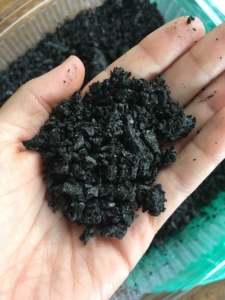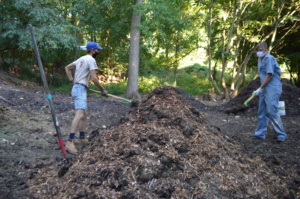While Grow Pittsburgh’s adult Master Composter students adapted, like many schools and events in the time of COVID, to online learning for this pilot year course, they still had a few chances to get outside and get their hands dirty with what they’ve been studying this season. “The master composters worked so hard through an incredibly hot, dry summer and during wild pandemic times,” says Russ Thorsen, Community Garden Coordinator and one of the instructors of the course along with Dan Dalton, Three Rivers Hub Manager for Pasa Sustainable Agriculture.
Participants came to the course with varying degrees of knowledge and experience with different composting methods. Deirdre Keller, an educator at Environmental Charter School, leads the school’s garden program and has been wanting to improve upon their composting for a while now. Pat Buddemeyer, a community gardener at Larimer’s African Healing Garden, first learned of composting while reading Rodale’s Organic Gardening magazine in the 60’s and has been composting herself for the past 20 years. One thing they all shared was their eagerness to get into the nitty gritty of soil science and decomposition, as well as the different systems that exist beyond the traditional backyard pile that many of us conjure up in our minds when we think of compost.

Completed biochar made at Garfield Farm
One of these unique methods brought them to Garfield Community Farm to learn about biochar, a charcoal-like material made by burning organic matter, that keeps carbon out of the air and returns it to our carbon-deficient soils. Traditionally, and in the context of Garfield Farm, biochar is created by burning wood, but “there’s still research and experimentation being done on all types of waste streams,” explains Thorsen, citing pistachio nuts and paper mill waste as examples. The biochar at Garfield Farm is made from wood that was once destined for the dumpster but now is saved to burn down into this “magical pixie dust”, as one student referred to it, within about an hour and a half of processing time. John Creasy, director of Garfield Farm, also walked the master composters through his method of compost tea at the farm, a combination of plant material, water, a microbial innoculant and molasses left to ferment until the valuable plant nutrients are extracted into liquid form and can be used as a nutrient-rich fertilizer or compost starter.

Turning one of the piles at the Stanton Heights composting site
Another excursion was to the Stanton Heights Community Composting site, an impressive, largely one-man operation tended by Mike Sturges, using what’s known as the Berkeley Method. Sturges uses this rapid composting method at his site to take organic waste from neighborhood residents and turn it into large quantities of nutrient-rich compost for area community and school gardens. He estimates he gave away more than $6000 worth of compost last season alone. Sturges led the class in an overview of his method: build a pile of organic green and brown material, let it sit for four days, and then turn it every two days for two weeks. The key to this rapid system is the large scale of his piles which prevent heat loss and build up the necessary heat to expedite the decomposition process – 165 degrees to be exact. To give a sense of just how steamy the piles are, Sturges pulled out a thermos of tea that he stashed inside a plastic bag and buried into the pile that morning that had steeped in the hours since. He touts that he’s cooked veggies and eggs on a griddle over the heat of his compost as well.

Sturgess, far right, walks master composter students through his massive Berkeley Method operation.
These hands-on experiences, alongside their weekly online classes, helped master composter students devise the best solutions to each of their independent compost projects in their respective community and school gardens, a requirement for course completion and certification. “The stretched out nature of the course [due to COVID] ended up actually being really nice,” says Keller. “It allowed me to notice the changes in my own compost system that I tweaked as we went along.” Much like the patience and persistence required to create the perfect compost, the master composter students took this nontraditional season in stride. “I’m so proud of their commitment to reducing food waste, and building healthy soils for their communities,” says Thorsen, who hopes this pilot year will pave the way for more grassroots knowledge and capacity building to transform Pittsburgh soils for years to come.
Many thanks to Patagonia for generously funding the pilot year of the Master Composter program!
